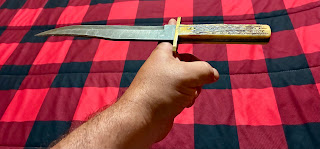In the comments to the post below, I mentioned that the 'balancing point' I keep talking about in my commentary is my own insight and not something I'm getting out of Aristotle's text. He uses words that are translated as "mean" or "intermediary," and students sometimes go wrong by missing that he doesn't mean the exact average or middle point. He is quite explicit about that repeatedly, as I've pointed out, but it remains a common misconception.
By the way, when I talk about the 'balancing point,' that's my own way of describing what Aristotle is after. He doesn't use that phrase or anything like it, but I think it's helpful in thinking about how a 'mean' or 'intermediate' can be 'closer to one end than the other.'I'm thinking of that thing we do to test the balance of a blade, where you put it longways across one finger and find where it balances. The blade may be longer than the hilt, but the hilt is more densely constructed; if so, the blade's tip may be much further out from your finger than the tip of the hilt, but it balances there. That's just another analogy, of course, and it's one I'm creating and importing to the text. It's not there in the original; I just find it helpful in conceptualizing the model.
Here is what I mean by that.
Balancing point on a Type XII arming sword, common c. 13th century.
Balancing point on a typical American Bowie knife.
As you can see, the balancing point is sometimes much closer to the middle, and sometimes much closer to one end than the other. The blade is balanced perhaps well forward of the guard, perhaps nearly upon it. Sometimes it's the exact middle of the blade, which we sometimes refer to as 'perfectly balanced,' but sometimes the tip of the blade extends well beyond the balancing point.
Again, it's just another analogy, and it's mine instead of Aristotle's. If you find it helpful in conceptualizing the point he's making about finding the exactly right place between two extremes, however, that's good. Use the analogy as far as it is useful.
It does amuse me to wonder if Aristotle's most famous student had this insight, and if he brought it to his master's attention. That student was well-familiar with such tools! If so, however, it didn't survive to us in the text.
UPDATE: It occurs to me that I ought to point out that blades are balanced the way they are for a reason: even if we speak of a 'perfectly balanced' blade as being in the exact middle, that doesn't mean another way is wrong. A perfectly balanced knife is good for throwing, though you can throw any of them if you can figure out their rotation properly. I enjoy axe throwing, and usually the axes aren't balanced with that consideration at all. You just have to figure out how far away you have to stand to have them strike at the correct point in their rotation.
A rapier (and similarly, thrusting weapons) is often balanced 'towards the hilt' as this allows the point to be moved rapidly and precisely to a desired position. Having most of the weight closer to the hand, or in the hand, means that smaller and gentler movements can be used to direct the point to exactly where you want it to go.
A slashing weapon is often balanced 'towards the blade.' This is because a sword is essentially a lever, and the lever's effect is greatest at the opposite end of the lever rather than in the middle. Since F=ma, putting more of the mass towards the place where the lever will exert more force on it increases the acceleration the lever produces, and thus the force of impact.
All of these considerations also have analogs to ethics. Ethics is about getting things inside us right to deal with the world outside of us. Thus, we too may find that the correct balancing point is sometimes here, and sometimes over there. It's not an operation of looking inside of ourselves and determining how much bravery, or anger, or temperance is best for us: we also have to consider how much the external situation requires.



2 comments:
I enjoy axe throwing.... You just have to figure out how far away you have to stand to have them strike at the correct point in their rotation.
I know nothing of axe throwing, so please educate me. Wouldn't it be possible also to control the rotation rate without sacrificing force, and so--within limits--be able to throw from any distance?
And: axes, knives, etc--aside from the sport of it, why would anyone want to throw away his weapons?
Eric Hines
So, it's a much better bartime activity than a combat technique. There's an axe-throwing bar close to here that my son and I go to sometimes. It's like darts, but cooler.
It's 100% about getting the distance exactly right for the rotation of the axe. Once you do, you can stick it every time and you're just working on accuracy. Until you do, it'll ricochet every time because there's only a short window in which it'll land right.
Throwing more or less hard does very slightly affect rotation, but not substantially. It's hard to modulate. It's more effective to be consistent and manage the distance.
Still, it's good fun. On our run up to DC for the Memorial Day ride from the Pentagon, we stopped in Front Royal, VA and found such a place also right by our hotel. We both scored bullseyes and got to wear the Viking helmet that bar awards for such things, as well as getting to write our names on the wall. It was a pleasant bonding experience.
It's not a combat technique I would recommend, for the reason you offer.
Post a Comment